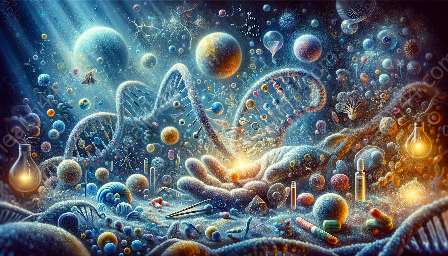The central dogma of molecular genetics is a fundamental principle that explains the flow of genetic information within a biological system. It elucidates the intricate processes of DNA replication, transcription, and translation, and forms the basis for understanding the hereditary transmission of genetic traits.
This topic cluster will delve into the central dogma of molecular genetics and its significance in unraveling the complexities of genetic mechanisms, shedding light on the roles of DNA, RNA, and proteins in the regulation and expression of genetic information.
Understanding the Central Dogma
The central dogma of molecular genetics, as proposed by Francis Crick in 1958, encapsulates the sequential flow of genetic information from DNA to RNA to protein, outlining the fundamental processes that underpin genetic expression and inheritance.
DNA Replication:
The core tenet of the central dogma begins with DNA replication. In this process, the genetic code stored in the DNA double helix is faithfully duplicated to ensure the transfer of genetic information to subsequent generations of cells. The precise and accurate replication of DNA is essential for maintaining the integrity of genetic material and for enabling the transmission of inherited traits.
Transcription:
Following DNA replication, the genetic information encoded in the DNA molecule is transcribed into messenger RNA (mRNA) through a process known as transcription. During transcription, an RNA polymerase enzyme catalyzes the synthesis of a complementary mRNA strand based on the template strand of DNA. This mRNA molecule carries the genetic instructions from the DNA to the ribosomes for translation.
Translation:
Translation is the final step in the central dogma, where the genetic code carried by the mRNA is decoded to produce specific proteins. In this process, the mRNA interacts with the ribosomes, and transfer RNA (tRNA) molecules bring specific amino acids based on the codons of the mRNA, leading to the synthesis of polypeptide chains that fold into functional proteins. These proteins play pivotal roles in various cellular functions and contribute to the phenotypic traits of an organism.
The Role of DNA, RNA, and Proteins
The interactions among DNA, RNA, and proteins are central to the functioning of the central dogma and represent the core processes that enable the flow of genetic information. DNA serves as the repository of genetic instructions, carrying the blueprint for the synthesis of proteins and other cellular components. RNA, on the other hand, acts as an intermediary, facilitating the transfer of genetic information from DNA to the protein synthesis machinery.
Furthermore, proteins, which are the ultimate products of gene expression, govern a wide array of biological processes, including enzymatic reactions, structural organization, and cellular signaling. The central dogma elucidates how the information encoded in DNA is transcribed into RNA and subsequently translated into proteins, thereby driving the functional diversity and adaptability of living organisms.
Implications for Genetics
The central dogma of molecular genetics has profound implications for the field of genetics, offering valuable insights into the mechanisms governing genetic variation, heritability, and evolutionary processes. By delineating the sequential flow of genetic information, the central dogma provides a framework for understanding genetic diseases, developmental processes, and the molecular basis of inherited traits.
Moreover, advancements in molecular genetics have elucidated exceptions to the central dogma, such as the discovery of non-coding RNAs and RNA-mediated regulation of gene expression, expanding our comprehension of the complexities underlying genetic information transfer.
Conclusion
Unraveling the central dogma of molecular genetics is crucial for comprehending the intricate processes that dictate the transmission and expression of genetic information. By elucidating the roles of DNA, RNA, and proteins in genetic processes, the central dogma serves as a cornerstone of modern genetics, offering profound insights into the functional dynamics of living organisms and the underlying mechanisms of heredity.


